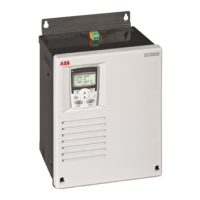226
Signal and parameter list
3ADW000379R0501 DCS550 Manual e e
40.16 PID OutMin (PID controller minimum limit output value)
Minimum limit of the PID controller output value in percent of the used PID controller input.
Int. Scaling: 100 == 1 % Type: SI Volatile: N
40.17 PID OutMax (PID controller maximum limit output value)
Maximum limit of the PID controller output value in percent of the used PID controller input.
Int. Scaling: 100 == 1 % Type: SI Volatile: N
40.18 PID OutDest (PID controller destination of output value)
Index pointer to the sink for the PID controller output value. The format is
-xxyy, with: -
= negate output value,
xx
= group and yy = index.
As default, nothing is connected to the output
.
Int. Scaling: 1 == 1 Type: SI Volatile: N
40.19 PID ResetIndex (PID controller reset index)
The PID controller reset and hold can be controlled by a selectable bit
- see PID ResetBitNo (40.20) - of the
parameter) selected with this parameter. The format is -xxyy, with: - = invert reset signal, xx =
yy = index.
If PID ResetIndex (40.19) = 701 (main control word) and PID ResetBitNo (40.20) = 12 then the PID
controller reset is active when bit 12 is high.
If PID ResetIndex (40.19) = -701 (main control word) and PID ResetBitNo (40.20) = 12 then the PID
controller reset is active when bit 12 is low.
Int. Scaling: 1 == 1 Type: SI Volatile: N
40.20 PID ResetBitNo (PID controller reset bit number)
Bit number of the signal/parameter selected with
PID ResetIndex (40.19).
Int. Scaling: 1 == 1 Type: I Volatile: N
40.22 PID OutScale (PID controller output scaling)
PID output scaling before
PID Out (3.09).
Int. Scaling: 100 == 1 Type: I Volatile: N
40.23 PID ReleaseCmd (PID controller release command)
Source to release / block the PID controller:
NotUsed constant 0; block PID controller
Auto depending on winder logic and winder macro, see WinderMacro (61.01), default
Release constant 1; release PID controller
WindCtrlWord according to WindCtrlWord (61.16) bit 6
DI1 1= release; 0 = block PID controller
DI2 1= release; 0 = block PID controller
DI3 1= release; 0 = block PID controller
DI4 1= release; 0 = block PID controller
DI5 1= release; 0 = block PID controller
DI6 1= release; 0 = block PID controller
DI7 1= release; 0 = block PID controller
DI8 1= release; 0 = block PID controller
DI9 1= release; 0 = block PID controller; only available with digital extension board
DI10 1= release; 0 = block PID controller; only available with digital extension board
DI11 1= release; 0 = block PID controller; only available with digital extension board
MCW Bit11 1= release; 0 = block PID controller; MainCtrlWord (7.01) bit 11
MCW Bit12 1= release; 0 = block PID controller; MainCtrlWord (7.01) bit 12
MCW Bit13 1= release; 0 = block PID controller; MainCtrlWord (7.01) bit 13
MCW Bit14 1= release; 0 = block PID controller; MainCtrlWord (7.01) bit 14
MCW Bit15 1= release; 0 = block PID controller; MainCtrlWord (7.01) bit 15
19.05Bit0 1= release; 0 = block PID controller; Data5 (19.05) bit 0
19.05Bit1 1= release; 0 = block PID controller; Data5 (19.05) bit 1
19.05Bit2 1= release; 0 = block PID controller; Data5 (19.05) bit 2
19.05Bit3 1= release; 0 = block PID controller; Data5 (19.05) bit 3
Int. Scaling: 1 == 1 Type: I Volatile: N

